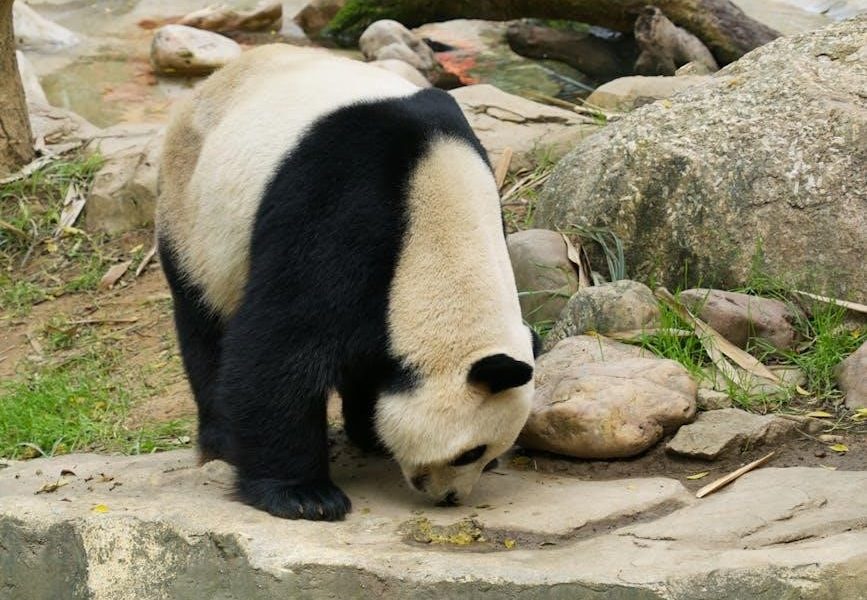The Gummy Bear Osmosis Experiment is a fun, educational activity that demonstrates osmosis using gummy bears soaked in various solutions, teaching water absorption and cellular processes․
Overview of the Experiment
The Gummy Bear Osmosis Experiment is a hands-on activity designed to demonstrate the concept of osmosis using gummy bears․ By soaking gummy bears in various solutions like distilled water, salt water, or sugar water, students can observe how water moves in and out of the gummy bears, causing them to swell or shrink․ This experiment provides a visual representation of osmosis, helping to explain how water molecules flow from areas of high concentration to low concentration through a semipermeable membrane․ The simplicity of the experiment makes it an engaging way to teach osmosis, particularly for students in elementary or middle school․
Importance of the Experiment in Understanding Osmosis
The Gummy Bear Osmosis Experiment is a valuable tool for understanding osmosis, as it provides a tangible and engaging way to visualize the movement of water molecules across a semipermeable membrane․ By observing how gummy bears absorb or lose water in different solutions, students can grasp key concepts like concentration gradients and equilibrium․ This experiment simplifies complex biological processes, making it accessible for learners of all ages․ It also highlights the role of osmosis in real-world scenarios, such as how cells maintain water balance․ The experiment fosters curiosity and scientific inquiry, helping students develop a deeper appreciation for cellular biology and the natural world․
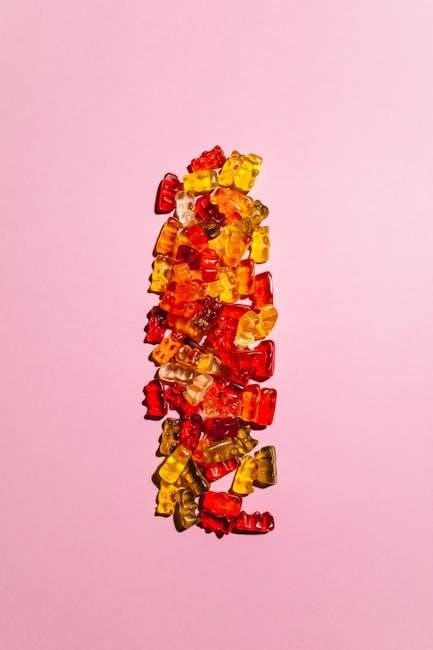
The Science Behind the Experiment
Osmosis is the movement of water across a semipermeable membrane, a vital biological process; Gummy bears, made of gelatin, effectively demonstrate this when soaked in different solutions․
What is Osmosis?
Osmosis is the movement of water molecules from an area of high concentration to an area of low concentration through a semipermeable membrane․ This process is essential in biology, enabling cells to maintain fluid balance and absorb nutrients․ In the gummy bear experiment, osmosis is observed as water enters or exits the gelatin structure, causing the gummy bear to swell or shrink․ The gummy bear acts as a model for cellular osmosis, demonstrating how cells respond to different environments․ This visual representation helps students grasp the concept of osmotic pressure and equilibrium, making it a practical tool for scientific education․
How Gummy Bears Demonstrate Osmosis
Gummy bears, made of gelatin, act as a semipermeable membrane, allowing water molecules to pass through while retaining larger sugar molecules․ When soaked in water, water enters the gummy bear through osmosis, causing it to swell․ Conversely, in salt water, water exits the gummy bear, shrinking it․ This visible change illustrates the movement of water molecules from high to low concentration areas, mirroring osmosis in living cells․ The gummy bear’s size change provides a tangible representation of osmotic pressure and equilibrium, making it an engaging and effective teaching tool for understanding osmosis in a hands-on manner․
Role of Gelatin in Gummy Bears
Gelatin, a key component of gummy bears, forms a flexible, semi-permeable matrix that allows water molecules to pass through while retaining larger sugar molecules․ This property mimics biological cell membranes, making gummy bears ideal for demonstrating osmosis․ The gelatin structure absorbs water when placed in a hypotonic solution, causing the gummy bear to swell, and releases water in hypertonic solutions, leading to shrinkage․ This absorption capability is central to the experiment, as it visually illustrates how osmotic pressure and concentration gradients drive water movement, providing a clear and engaging representation of osmotic processes in a simple, accessible way․
Concentration Gradients and Water Movement
In the gummy bear osmosis experiment, concentration gradients drive water movement․ When a gummy bear is placed in distilled water, water flows into the bear due to the higher concentration of solutes inside, causing it to swell․ Conversely, in salt water, the higher external solute concentration causes water to flow out, shrinking the gummy bear․ This demonstrates how osmotic pressure pushes water from areas of low solute concentration to high, through the semipermeable gelatin membrane․ The experiment vividly illustrates the role of concentration gradients in determining the direction and rate of water movement, mirroring osmotic processes in living cells and biological systems․
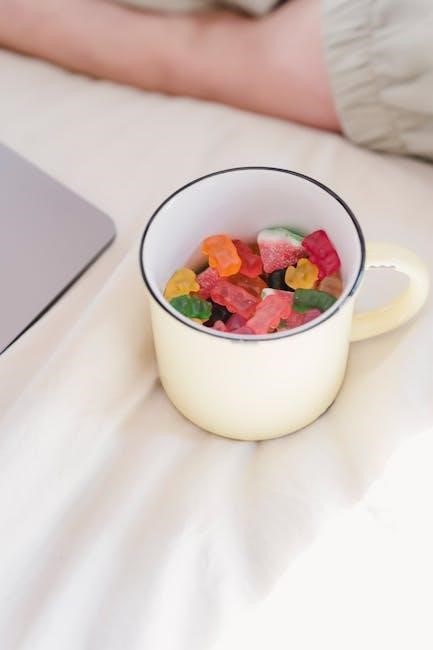
Materials Needed for the Experiment
Beakers, gummy bears, distilled water, salt water, measuring tools (ruler, balance), paper, and pens are required for this experiment to observe osmotic changes effectively․
Equipment Required
Beakers or cups are essential for holding the gummy bears and solutions․ A ruler is needed to measure the gummy bears’ length, width, and height; A balance or scale measures mass changes, indicating water absorption or loss․ Measuring cups or spoons are useful for preparing precise solution concentrations․ Paper and pens record observations and data․ Optional items include markers for labeling beakers and permanent markers for writing on gummy bears․ These tools help track changes in size and mass, providing clear, measurable results to analyze osmosis effectively․ Having these materials ensures a well-organized and informative experiment․
Liquids to Test (Distilled Water, Salt Water, etc․)
Commonly tested liquids include distilled water, salt water, vinegar, corn syrup, and baking soda solutions․ Distilled water, with no solutes, allows gummy bears to absorb water freely․ Salt water creates a hypertonic solution, causing the gummy bears to lose water․ Vinegar and corn syrup introduce different solute concentrations, altering osmosis rates․ These liquids help demonstrate how varying solute levels affect water movement in and out of the gummy bears․ By testing multiple solutions, students can observe and compare the effects of different environments on osmosis, providing insights into how cells respond to varying concentrations in real-world biological scenarios․ This variety enhances the experiment’s educational value․
Measurement Tools
Essential measurement tools include a ruler for length, width, and height measurements, and a balance or scale to measure mass․ A timer is used to track soaking duration․ These tools help record gummy bears’ size and mass before and after soaking, providing quantitative data․ Some experiments also use charts or worksheets for documentation․ Accurate measurements ensure reliable results, allowing students to analyze osmosis effects effectively․ These tools are simple yet crucial for understanding water absorption and loss in gummy bears, making the experiment both educational and engaging while teaching scientific measurement skills․
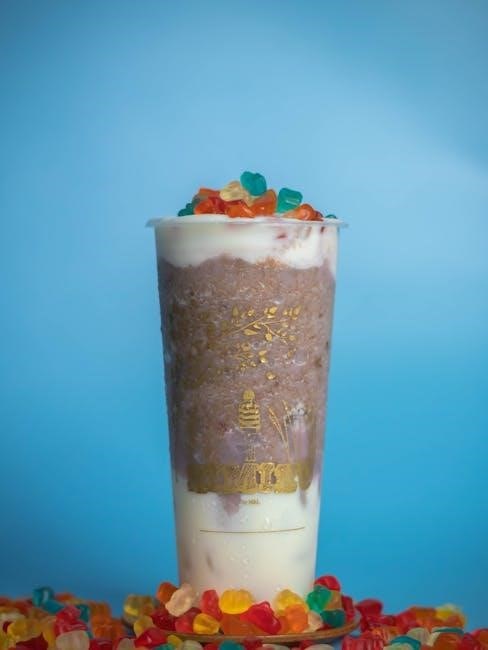
Procedure for the Gummy Bear Osmosis Experiment
Soak gummy bears in distilled water, salt water, or other solutions for 24 hours․ Measure and record size and mass initially and after soaking․ Observe changes․
Step 1: Prepare the Gummy Bears
Begin by selecting several gummy bears of similar size and shape․ Rinse them gently with water to remove any surface dirt or residue․ Pat them dry with a paper towel to ensure they are not damp․ Next, measure and record their initial length, width, and mass using a ruler and balance․ This step establishes a baseline for comparison after soaking․ Ensure the gummy bears are completely dry before proceeding, as any moisture could affect the experiment’s accuracy․ Proper preparation ensures consistent and reliable results when observing osmosis․
Step 2: Set Up the Beakers
Label each beaker with the type of liquid it will contain, such as distilled water, salt water, or other solutions like vinegar or sugar water․ Ensure each beaker is large enough to hold the gummy bear completely submerged․ Pour the chosen liquid into each beaker, leaving enough space to cover the gummy bear entirely․ Use a permanent marker to clearly label the beakers to avoid confusion․ Double-check that each beaker is properly prepared and placed on a stable surface․ This step ensures the experiment is organized and ready for the next phase of soaking the gummy bears․
Step 3: Measure Initial Size and Mass
Before soaking, measure the gummy bear’s initial size using a ruler to record its length, width, and height․ Note its mass using a balance scale․ Document these measurements accurately, as they serve as a baseline for comparison after osmosis occurs․ Ensure the gummy bear is dry and undamaged to get precise readings․ This step is crucial for tracking changes in size and mass caused by water absorption or loss during the experiment․ Record the data in a chart or table for easy reference later․ Handle the gummy bear gently to avoid altering its shape or mass before the experiment begins․
Step 4: Soak the Gummy Bears
Submerge the gummy bears in the prepared solutions, ensuring they are fully covered․ Place each bear in separate beakers containing different liquids like distilled water, salt water, or other solutes․ Cover the beakers to minimize evaporation․ Allow the bears to soak for 24-48 hours, depending on the solution’s concentration and desired observation time․ During this period, osmosis will occur, causing the bears to absorb or lose water․ Monitor their condition periodically without disturbing them excessively․ After soaking, carefully remove the bears with a spoon, gently pat them dry with a paper towel to remove excess liquid, and prepare for measurement and observation․ This step is critical for observing osmotic effects․
Step 5: Record Observations
After soaking, carefully remove each gummy bear from its solution and gently pat it dry with a paper towel to remove excess liquid․ Measure and record its length, width, and mass using a ruler and scale․ Note any visible changes, such as swelling, shrinking, or color alteration․ Compare the results across different solutions to observe variations in water absorption or loss․ Document the findings in a chart or table, including before-and-after measurements․ Photograph the gummy bears to visually capture the effects of osmosis․ This step helps analyze how different solutes affect water movement in and out of the gummy bear, providing clear evidence of osmotic processes․

Key Observations and Results
Gummy bears expand in distilled water due to water absorption via osmosis, while they shrink in saltwater as water leaves the bear, demonstrating solute concentration effects․
Changes in Size and Mass
During the experiment, gummy bears soaked in distilled water absorb water through osmosis, leading to a noticeable increase in size and mass․ Measurements before and after soaking show significant swelling, as water molecules enter the gelatin structure․ In contrast, gummy bears placed in hypertonic solutions like salt water lose water, causing them to shrink and lose mass․ The mass increase in distilled water can be up to 20-25%, while in salt water, the mass decreases due to water loss․ These changes are visually evident, with the gummy bears becoming larger and softer in water and smaller and harder in salt solutions, clearly demonstrating osmosis․
Effect of Different Liquids on Gummy Bears
The experiment reveals how different liquids affect gummy bears through osmosis․ When soaked in distilled water, gummy bears absorb water, swell, and increase in size and mass due to the high water concentration․ In salt water, they lose water, shrink, and become smaller and harder as the salt concentration exceeds that of the gummy bear․ Testing with vinegar, corn syrup, or baking soda solutions shows varied effects, with vinegar potentially softening the gelatin and corn syrup causing significant shrinkage due to high sugar concentration․ These observations demonstrate how solute concentration in liquids influences water movement, aligning with osmotic principles and providing insights into cellular processes in living organisms․
Visual Evidence of Osmosis
The Gummy Bear Osmosis Experiment provides clear visual evidence of osmosis․ When gummy bears are soaked in distilled water, they swell significantly, becoming larger and softer, as water molecules flow into the bear․ In contrast, when placed in salt water, the bears shrink and harden, as water is drawn out․ These physical changes are easily observable and demonstrate the movement of water across the gelatin membrane․ Photographing the bears before and after soaking in different solutions captures the transformation, offering a tangible representation of osmosis․ This visual evidence helps students and observers understand the concept of water movement from high to low concentration, making the abstract process of osmosis concrete and engaging․

Analysis of the Experiment
The Gummy Bear Osmosis Experiment effectively demonstrates how water moves across a semipermeable membrane, supporting the theory of osmosis and its role in biological systems․
Understanding Why Gummy Bears Expand or Shrink
Gummy bears expand or shrink due to osmosis, the movement of water across a semipermeable membrane․ When placed in distilled water, water flows into the gummy bear, causing it to swell as the gelatin absorbs water․ In salt water, the high solute concentration outside the gummy bear draws water out, shrinking it․ This process mimics how cells in living organisms regulate water balance․ The gelatin in gummy bears acts as a semipermeable membrane, allowing water molecules to pass while retaining larger solute particles․ This experiment visually demonstrates the principles of osmosis, helping students grasp how concentration gradients influence water movement in biological systems․
Comparison of Results Across Liquids
The experiment reveals distinct outcomes when gummy bears are soaked in different liquids․ In distilled water, gummy bears absorb water, swell significantly, and become larger due to osmosis․ In salt water, they lose water, shrink, and harden as the high solute concentration pulls moisture out․ Vinegar and baking soda solutions may affect texture but show less dramatic size changes․ These variations demonstrate how solute concentration influences water movement․ Comparing results across liquids helps visualize osmotic effects, showcasing how different environments impact the gummy bears’ size and mass․ This comparison aids in understanding osmotic principles and their real-world biological applications, such as cell hydration and dehydration processes․
Implications for Real-World Biology
The gummy bear osmosis experiment provides insights into real-world biological processes․ Osmosis is essential for cell hydration, nutrient transport, and waste removal in living organisms․ The experiment mimics how cells respond to different environments, such as swelling in hypotonic solutions or shrinking in hypertonic solutions․ Understanding osmosis helps explain phenomena like plant water absorption and human cell function․ It also relates to medical concepts, such as dialysis and cell hydration․ By observing gummy bears, students gain a tangible understanding of osmotic principles, which are fundamental to biology and medicine․ This experiment bridges the gap between simple demonstrations and complex biological systems, making osmosis relatable and accessible for learners of all ages․

Variations and Extensions of the Experiment
Explore variations by testing different solutions, such as saltwater, vinegar, and sugar water․ Measure osmotic potential and observe long-term effects for a deeper understanding of osmosis dynamics․
Testing Different Liquids
Testing various liquids, such as distilled water, saltwater, vinegar, and corn syrup, allows students to observe how solute concentration affects osmosis․ By immersing gummy bears in these solutions, they can witness how the bears expand or shrink based on water absorption or loss․ For example, in distilled water, gummy bears swell due to high water absorption, while in saltwater, they shrink as water leaves the bear․ This experiment helps visualize the impact of solute concentration on osmotic processes, providing a hands-on understanding of how different environments influence cellular behavior․ It also encourages students to hypothesize and compare results across multiple liquids․
Measuring Osmotic Potential
Measuring osmotic potential involves determining the point at which a gummy bear neither swells nor shrinks, indicating equilibrium․ By soaking gummy bears in solutions of increasing sucrose concentration, students can identify the isotonic point․ This is done by measuring the bear’s mass and volume before and after immersion․ The solution that matches the bear’s osmotic potential will show no net change․ This method teaches students how to quantify osmotic pressure and understand its role in biological systems․ It also highlights the practical application of osmosis in determining solute concentrations, making abstract concepts more tangible and engaging for learners․
Long-Term Observations
Long-term observations of gummy bears in various solutions reveal significant changes over extended periods․ Gummy bears soaked in distilled water typically swell to their maximum size within 24-48 hours due to continuous water absorption․ In salt water, they shrink gradually, losing water and becoming smaller and harder․ Over several days, gummy bears in sugary solutions may develop a sticky coating due to sugar crystallization․ Observing these changes helps students understand the prolonged effects of osmosis and how different solute concentrations impact cellular structures․ This extended study enhances the experiment’s educational value, demonstrating the dynamic nature of osmosis and its real-world biological implications․
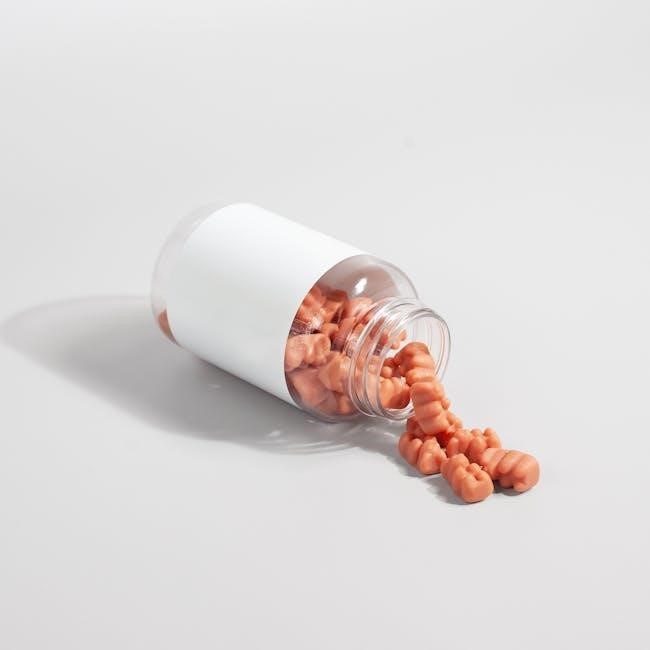
Safety Tips and Precautions
- Handle chemicals like salt and sugar carefully to avoid spills and skin irritation․
- Wear protective gloves and goggles when preparing solutions․
- Ensure the workspace is clean and dry to prevent accidents․
Handling Chemicals Safely
When conducting the gummy bear osmosis experiment, handle all chemicals with care․ Wear protective gloves and goggles to avoid skin or eye irritation, especially when working with salt, sugar, or vinegar․ Ensure the workspace is clean and dry to prevent accidental spills․ Read the labels on all substances carefully before use․ Avoid ingesting any chemicals, even if they are household items․ Properly dispose of leftover solutions and clean utensils thoroughly after use․ Keep the area well-ventilated to prevent inhaling dust or fumes․ Supervise children closely to ensure they follow safety guidelines․ This ensures a safe and enjoyable learning experience for everyone involved․
Ensuring a Clean Environment
Before starting the gummy bear osmosis experiment, ensure the workspace is clean and organized․ Cover the table with disposable paper or a plastic tablecloth to prevent spills from staining surfaces․ Have a trash bin nearby for disposing of waste materials․ Clean and rinse all utensils and beakers thoroughly before use․ Store chemicals and liquids in their original containers when not in use․ After the experiment, wash hands and clean all equipment with soap and water․ Properly dispose of any leftover solutions and gummy bears․ Maintaining a clean environment prevents contamination, ensures safety, and makes the experiment more efficient and enjoyable for everyone involved․

Educational Value of the Experiment
The gummy bear osmosis experiment is a hands-on, engaging way to teach students about osmosis, cell membranes, and water movement, fostering scientific curiosity and learning through observation․
Teaching Osmosis to Students
The gummy bear osmosis experiment is a simple yet effective way to teach students about osmosis․ By observing how gummy bears absorb or lose water in different solutions, students can visualize the concept of water movement across a semipermeable membrane․ This hands-on activity helps students understand the role of solutes and solvents in osmosis, making it easier to grasp complex biological processes․ The experiment aligns with educational standards, promoting scientific inquiry and critical thinking․ It also encourages students to explore real-world applications of osmosis, such as its role in human physiology and plant biology․ This engaging approach fosters curiosity and deeper understanding of cellular processes․
Developing Scientific Inquiry Skills
The gummy bear osmosis experiment fosters scientific inquiry by encouraging students to formulate hypotheses, conduct observations, and analyze results․ By predicting how gummy bears will change in different solutions, students develop critical thinking skills․ Measuring and recording data helps refine their attention to detail and analytical abilities․ This experiment also teaches the scientific method, as students test variables like solution type and soaking time․ Collaborative discussions and reflections on results enhance communication and problem-solving skills․ Through hands-on exploration, students gain confidence in their ability to investigate scientific phenomena, preparing them for more complex experiments in the future․ This experiential learning approach makes science engaging and accessible․
The gummy bear osmosis experiment provides a visual understanding of osmosis, helping students grasp complex biology concepts through hands-on, engaging activities․
The gummy bear osmosis experiment demonstrates how water moves across a semipermeable membrane, with gummy bears absorbing or losing water based on solution concentration․ In distilled water, gummy bears swell due to osmosis, while in salt water, they shrink as water flows out․ The gelatin in gummy bears acts as a membrane, allowing water to pass while retaining larger molecules․ This experiment visually illustrates osmosis, showing how cells might behave in different environments․ The results highlight the importance of concentration gradients in water movement, providing a clear, hands-on understanding of osmotic processes for students․
Encouraging Further Exploration
This experiment sparks curiosity and encourages further investigation into osmosis․ Students can explore how different liquids, such as vinegar or corn syrup, affect gummy bears․ Measuring osmotic potential or observing long-term changes can deepen understanding․ Encouraging variations, like testing various soak times or shapes, promotes critical thinking․ Comparing results with real-world biological processes, such as cell behavior in different solutions, enhances learning․ This hands-on approach fosters a love for science and inspires questions about how osmosis impacts living organisms․ Further exploration can include creating hypotheses for new experiments, analyzing data, and drawing conclusions about the role of osmosis in nature․
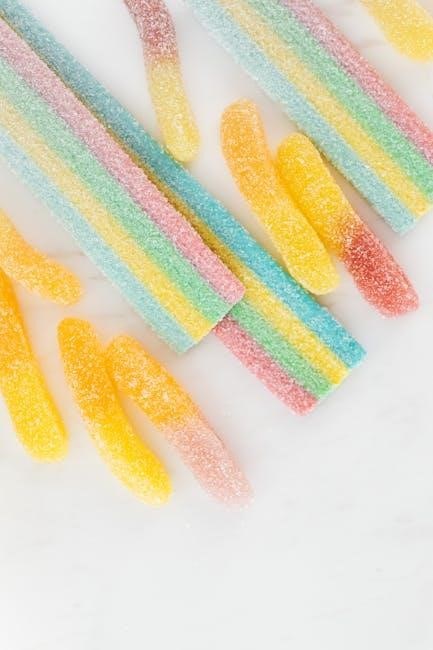
Further Reading and Resources
Explore detailed guides and additional experiments through recommended PDF resources and websites like Science Dipity for comprehensive insights․
Recommended PDF Guides
For a deeper understanding, explore the Michigan․gov PDF guide on gummy bear osmosis, offering detailed lab procedures and student worksheets․ Another excellent resource is the Science Dipity guide, which provides step-by-step instructions and scientific explanations․ These PDFs are ideal for educators and students, covering osmosis basics, experimental setups, and data analysis․ They also include variations, such as testing with saltwater or sugar solutions, to enhance learning․ Download these guides to conduct a comprehensive and engaging gummy bear osmosis experiment․
Additional Experiments on Osmosis
Beyond gummy bears, explore osmosis with raisins soaked in soda or water to observe swelling․ Try the “Dancing Raisins Experiment” or use celery stems with food coloring to visualize water uptake․ For a more advanced look, investigate osmosis in potato slices soaked in salt or sugar solutions․ These experiments complement the gummy bear activity, offering diverse perspectives on osmosis; Additionally, the “Bouncy Egg Experiment” demonstrates osmotic effects on eggshell membranes․ These hands-on activities provide a comprehensive understanding of osmosis, making complex concepts accessible and engaging for learners of all ages․
